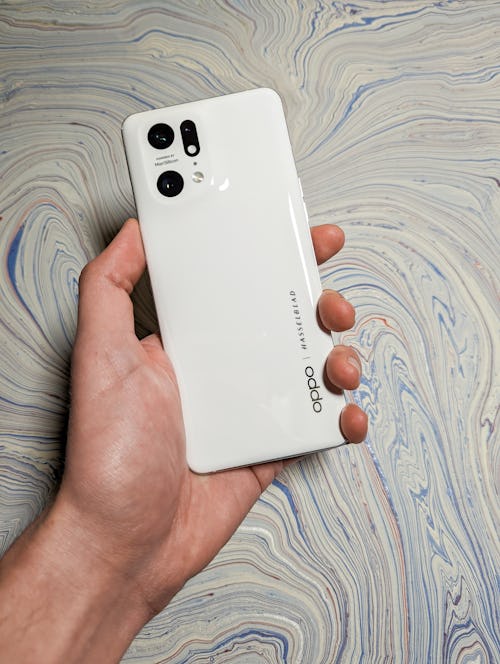
The Find X5 Pro 5G is all about the camera.
Oppo updated its flagship phone with the Snapdragon 8 Gen 1 like plenty of other Android phone makers have, but the real difference is the company’s MariSilicon X, a dedicated imaging NPU that the company claims dramatically improves how the $1,378 Find X5 Pro takes photos.
In my experience those improvements are real, I just wish some of the same attention that elevated the camera experience was spent on every other part of Oppo’s high-end Android phone. Especially when the company wowed me only a few months ago with the Oppo Find N 5G foldable.
Input may receive a portion of sales if you purchase a product through a link in this article. We only include products that have been independently selected by Input's editorial team.
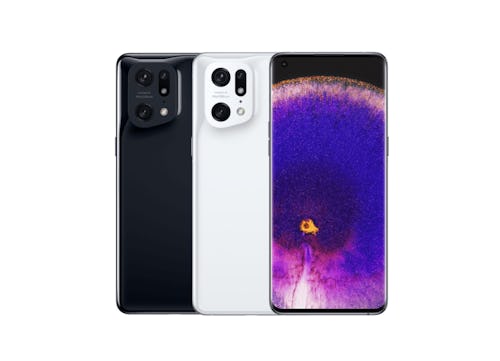
Cool to the touch
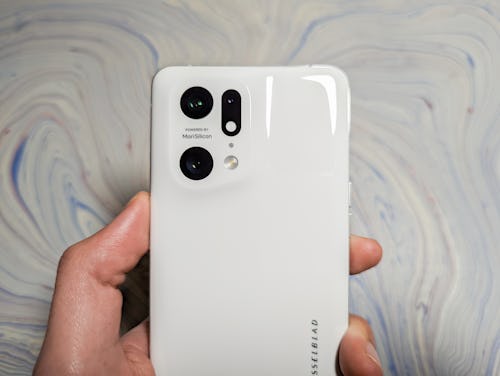
The Find X5 Pro isn’t a major departure from Oppo flagships of years past. You can draw a straight line from the Find X3 Pro with its microscope camera to the Find X5 Pro, especially in the device’s camera bumps, which both opt to smoothly rise out of the back of the phone rather sit on top like the iPhone 13 Pro or Pixel 6 Pro.
The entire ceramic-backed design of Oppo’s new phone is an exaggeration of some of the Find X3 Pro’s calling cards. The curve of the camera bump is more pronounced, creating this sort of delicate shadow when you look at the back of the Find X5 Pro from most angles. Those curves are repeated elsewhere in how the back of the Find X5 Pro curves into its metallic edges, and how the front high refresh rate display waterfalls ever so slightly off the sides. For a phone full of curves, Oppo’s new flagship is still a big tall rectangle. Luckily it just so happens to also be a giant rectangle that's both pleasant to look at and well-balanced in my hand.
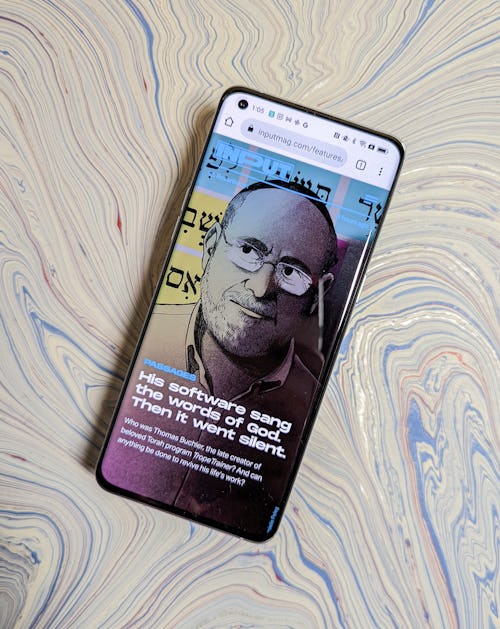
Frontside —
The 6.7-inch, 3,216 x 1,440 resolution AMOLED screen on the Find X5 Pro is fit for a flagship, with a refresh rate that can range anywhere from 1Hz at the lowest to 120Hz at the highest thanks to the phone's LTPO display. Oppo says the Find X5 Pro can reach a peak brightness of 1,300 nits with 8192 levels of brightness. In my experience, it's been easy to see outside, though maybe not as surprisingly clear as the 1,750-nit display tech in Samsung’s Galaxy S22+. It should be just as strong, too — both phones use Gorilla Glass Victus for added durability.
In the top left corner of the screen, there’s a 32-megapixel selfie camera with a 90-degree field of view, which can also be used to unlock the Find X5 Pro. But the safest method is still the under-display fingerprint reader, which, in my day-to-day use, was about as fast as the one on the Galaxy S22+. It also plays a customizable sparkly animation when it scans your finger — a plus in my opinion.
The Find X5 Pro charges over USB-C and comes with a 5,000 mAh battery. In a casual day of use, checking email and social media, and occasionally using Messenger, I got around a day and a half off the Find X5 Pro’s battery before I became concerned that I’d need to charge it. Oppo includes several fast charging options to go along with that increased capacity, including 80W SuperVOOC charging and 50W AirVOOC wireless charging. I wasn’t able to try wired fast charging using Oppo’s included 80W power brick because of its UK plug, but a 30W charger worked just fine too.
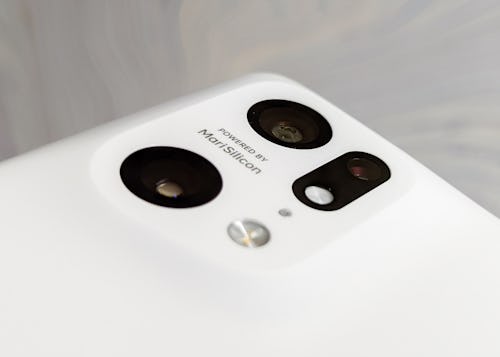
Backside —
The back of the device is where things get different. Rather than use glass, metal, or plastic like other phones, the Find X5 Pro is made of ceramic in either a black or white finish, which Oppo claims is twice as hard as glass and just as scratch-resistant. The white glaze calls to mind Apple’s ceramic Apple Watch Series 5 and even though it gets smudged easily and most of the time just looks like any other glass phone, I do have to say I love how classy it looks. The strangest thing I’ve appreciated about using a ceramic-backed phone is that when it gets cold — maybe it’s been sitting on my desk by an open window or I just haven’t used it in a while — it gets notably colder than many of the other personal electronics that I own. Weird, but cool.
The rest of the Find X5 Pro’s back is that previously mentioned camera bump. Oppo ditched the microscope camera this year, choosing what I think is smartphone photography bread a butter instead: a wide, ultra-wide, and telephoto lens. The main wide lens uses a 50-megapixel Sony IMX 766 sensor, the same 50-megapixel setup for the ultra-wide with its 110-degree field of view. The third camera is a smaller 13-megapixel telephoto. No surprises there, save for maybe “DSLR-level five-axis OIS (optical image stabilization)” on the wide.

Silicon —
Oppo’s real focus seems to be its new custom silicon chip, the MariSilicon X. The company is deeply proud of this imaging neural processing unit. So proud it has a dedicated section in the Find X5 Pro’s settings menu with a video explaining it. The Snapdragon 8 Gen 1 makes using the Find X5 Pro just as snappy as any other 2022 flagship phone. I think I really noticed the speed in camera tasks, though, which I have to chalk up at least in part to whatever magic Oppo is cooking up with MariSilicon X.
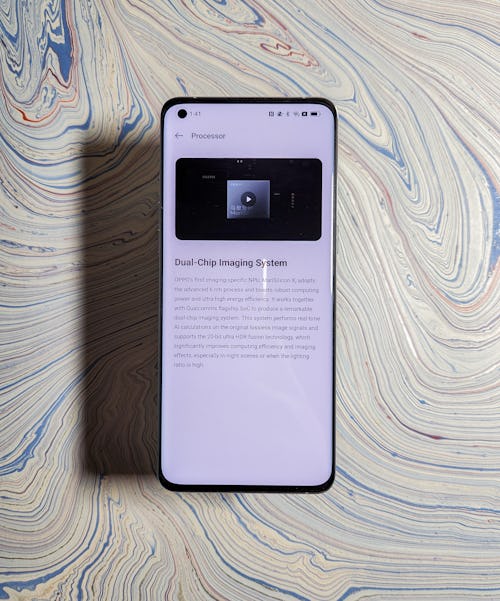
A perfect camera?
No, I can’t rightfully claim the Find X5 Pro is the perfect smartphone camera. There are too many variables and too many aesthetic qualities that ultimately come down to taste. But I do think this is absolutely my favorite Android smartphone camera system I’ve used to date, and I had more shots that felt “perfect” than any other phone I’ve used recently.
The Hasselblad effect —
A lot of that comes down to the choices the Find X5 Pro makes with both color and detail. Oppo (and OnePlus for that matter) are partnered with famous Swedish camera company Hasselblad for their smartphone camera systems. It’s a partnership that I always assumed was mainly about putting the Hasselblad logo on Oppo and OnePlus phones, but in the case of the Find X5 Pro amounts to a bit more. Oppo says that Hasselblad helped develop the phone's “natural color calibration” and a set of “master filters” for easier (and I think more gimmicky) paths to a “Hasselblad” look.
This is absolutely my favorite Android smartphone camera system.
To be fair, I’ve never used a real Hasselblad medium format camera and I largely avoided Oppo’s filters, but I'm deeply impressed by how elegant photos taken with the Find X5 Pro can turn out.
Wide lens
Photos taken with the main 50-megapixel sensor look great. Detailed and warm, but not ridiculously oversaturated. I felt confident I could shoot something ready for Instagram pretty much every time I whipped out the Find X5 Pro to snap a picture. It’s a camera that resists the need for touch-ups, in my opinion.
Ultra-wide lens

Results with the ultra-wide were more or less equally pleasing. Not too surprising considering both camera set-ups use the same Sony sensor. When I look back at shots, I can’t help but feel there’s a little less detail zooming in and there’s still a slight fisheye effect to deal with. Setting those aside, though, the Find X5 Pro still impresses.
Telephoto lens

I don’t think I’ll ever be totally happy with telephoto shots from smartphone cameras and I’m finally starting to accept that. The 2x telephoto performance on the Find X5 Pro is comparable to the Samsung Galaxy S22+, but I do sort of wish Oppo had done something a bit more experimental with its third camera or at least offered more zoom.
The microscope lens from the Find X3 Pro might not have been necessary, but it was something that no one else had. With a feature like a telephoto lens, which for basic physics reasons can’t really compare to what you could achieve with a DSLR telephoto, there’s less of a reason to use it unless you’re using it as a literal telescope. It just doesn’t look good otherwise.
Night photography
One of the ways the MariSilicon X is supposed to improve on Oppo’s past smartphone camera performance is by improving night shots. The results are less dramatic than I expected. In general, the Find X5 Pro takes a less dramatic approach to brightening night shots than the Galaxy S22+. It’s more naturalistic, but a bit dimmer.
I'm happiest with the night portraits. They’re more blurry than I think they should be but full of all the same details in hair and other fine textures that I'm impressed by in Samsung’s new phones. They also have my favorite use of color, with delicate blues and a realistically warm glow from lights.

Shooting moving targets like my family’s dog Peggy can still lead to less than stellar results, but otherwise, I’m left impressed.
Selfies and videos

The Find X5 Pro has a great selfie camera. It takes amazing portrait selfies. Seriously. Should it have a slightly wider field of view for group shots? Yes. I’ve really got nothing else to complain about. It makes me look good, and that's what I think just about everyone wants from a selfie camera.
Videos are equally impressive. The five-axis optical image stabilization keeps things consistently smooth and as luck would have it, a wide camera that’s great at still shoots pretty nice moving pictures too.
ColorOS needs to cool it

It’s very 2012 to complain about bloatware, I know, I know. But there are some pretty egregious examples of it in ColorOS 12 for the Find X5 Pro. If a company provides a settings menu toggle for a folder of “Hot Apps” that aren’t physically downloaded on your smartphone but take up space on the screen of your phone, I think we have a problem. I’m glad Oppo gives you an option to disable them, and I know these kinds of weird arrangements often subsidize the cost of some other part of the phone. But seriously, it should stop.
For the rest of ColorOS, it’s best to think about your relationship to another mobile operating system — Samsung's One UI. At this point, both OSes offer a similar density of extra settings, features and customizations. I appreciated them on a device with a unique form factor like the Find N 5G, because frankly, I needed help using the extra screen space. But on a regular old rectangle like the Find X5 Pro, using ColorOS often makes me wish for something more stripped down.
Great at being normal
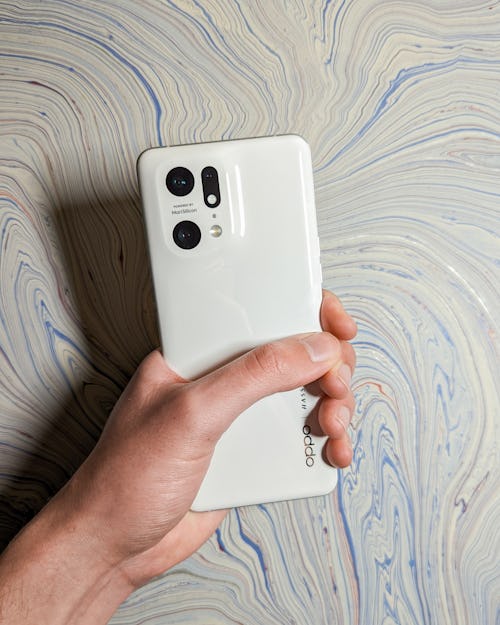
The Find X5 Pro is a solid alternative to Samsung’s global dominance in terms of performance. While it lacks unique camera features, there’s plenty of room to grow the software side of things now that Oppo’s designing its own chips. The Find X5 Pro will be available in the United Kingdom, Europe, Asia, and Australia on March 24. Notably missing: North America or the U.S. Not that that would stop anyone from finding a way to get this phone. It’s 2022, not 2022. The Find X5 Pro starts at £1,049 (around $1,378), pricey for sure.
My real problem with the Find X5 Pro is the same one I’m finding with every major flagship phone — we’re reaching a dead end. Phone makers continue to refine the performance of their phones, fine-tuning camera features, and polishing hardware designs from previous years. But people need something new to want to upgrade.
The Find X5 Pro is a solid alternative to Samsung’s global dominance.
The Find X5 Pro might not have that for everyone, especially if you’re attached to Oppo’s older camera designs. When it comes down to it, it’s a normal Android phone — with all the weird software skinning and bloatware that implies — with just a taste of what’s to come as Oppo explores developing hardware and software in tandem. Never buy a phone on the promise of future improvements, but if you’ve been looking for a great Android phone that’s not made by Samsung, Oppo just might have what you’re looking for.







